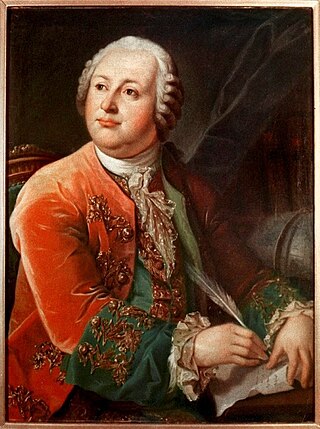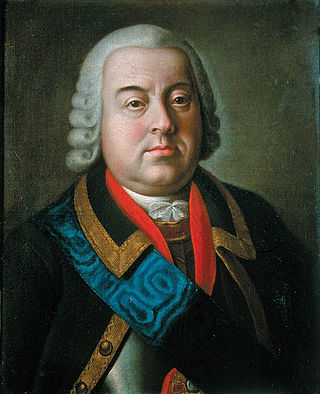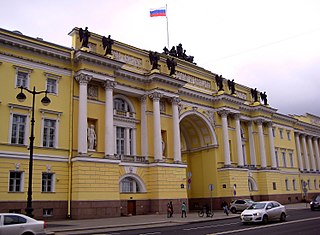| Years in Russia: | 1757 1758 1759 1760 1761 1762 1763 |
| Centuries: | 17th century · 18th century · 19th century |
| Decades: | 1730s 1740s 1750s 1760s 1770s 1780s 1790s |
| Years: | 1757 1758 1759 1760 1761 1762 1763 |

Events from the year 1760 in Russia
| Years in Russia: | 1757 1758 1759 1760 1761 1762 1763 |
| Centuries: | 17th century · 18th century · 19th century |
| Decades: | 1730s 1740s 1750s 1760s 1770s 1780s 1790s |
| Years: | 1757 1758 1759 1760 1761 1762 1763 |

Events from the year 1760 in Russia
| | This section needs expansion. You can help by adding to it. (October 2015) |
| | This section needs expansion. You can help by adding to it. (October 2015) |

Elizabeth or Elizaveta Petrovna reigned as Empress of Russia from 1741 until her death in 1762. She remains one of the most popular Russian monarchs because of her decision not to execute a single person during her reign, her numerous construction projects, and her strong opposition to Prussian policies.

Mikhail Vasilyevich Lomonosov was a Russian polymath, scientist and writer, who made important contributions to literature, education, and science. Among his discoveries were the atmosphere of Venus and the law of conservation of mass in chemical reactions. His spheres of science were natural science, chemistry, physics, mineralogy, history, art, philology, optical devices and others. The founder of modern geology, Lomonosov was also a poet and influenced the formation of the modern Russian literary language.

Vitebsk or Vitsebsk or Viciebsk is a city in Belarus. It is the administrative center of Vitebsk Region and Vitebsk District, though it is administratively separated from the district. As of 2023, it has 359,148 inhabitants, making it the country's fourth-largest city. It is served by Vitebsk Vostochny Airport and Vitebsk Air Base.

Prince Edward, Duke of York and Albany, was the younger brother of George III of the United Kingdom and the second son of Frederick, Prince of Wales, and Princess Augusta of Saxe-Gotha.

Semyon Ivanovich Chelyuskin was a Russian polar explorer and naval officer.

Karl Pavlovich Bryullov, original name Charles Bruleau, also transliterated Briullov and Briuloff, and referred to by his friends as "Karl the Great", was a Russian painter. He is regarded as a key figure in transition from the Russian neoclassicism to romanticism.

Prince Nikita Yurievich Trubetskoy was a Russian statesman and Field Marshal (1756), minister of defense of Russia 1760.

The Governing Senate was the highest legislative, judicial, and executive body subordinate to the Russian emperors, instituted by Peter the Great to replace the Boyar Duma and lasted until the very end of the Russian Empire. It was chaired by the Procurator General, who served as the link between the sovereign and the Senate; he acted, in the emperor's own words, as "the sovereign's eye".
Anton Pavlovich Losenko was a Russian neoclassical painter and academician who lived in Imperial Russia and who specialized in historical subjects and portraits. He was one of the founders of the Imperial Russian historical movement in painting.
James Trevenen was an officer in the Royal Navy and the Imperial Russian Navy.
During the Seven Years' War, the Prussian-held town of Kolberg in Brandenburg-Prussian Pomerania was besieged by Russian forces three times. The first two sieges, in late 1758 and from 26 August to 18 September 1760, were unsuccessful. A final and successful siege took place from August to December 1761. In the sieges of 1760 and 1761, the Russian forces were supported by Swedish auxiliaries.

The Seven Years' War (1756–1763) was a global conflict that involved most of the European great powers and was fought primarily in Europe, the Americas, and Asia-Pacific. Other concurrent conflicts include the French and Indian War (1754–1763), the Carnatic Wars (1744–1763), and the Anglo-Spanish War (1762–1763). The opposing alliances were led by Great Britain and France, respectively, both seeking to establish global pre-eminence at the expense of the other. Along with Spain, France fought Britain both in Europe and overseas with land-based armies and naval forces, while Britain's ally Prussia sought territorial expansion in Europe and consolidation of its power. Long-standing colonial rivalries pitted Britain against France and Spain in North America and the West Indies. They fought on a grand scale with consequential results. Prussia sought greater influence in the German states, while Austria wanted to regain Silesia, captured by Prussia in the previous war, and to contain Prussian influence.

Georg Franz Hoffmann was a German botanist and lichenologist. He was born on 13 January 1760 in Marktbreit, Germany, and died on 17 March 1826 in Moscow, Russia.

The Raid on Berlin took place in October 1760 during the Third Silesian War when Austrian and Russian forces occupied the Prussian capital of Berlin for several days. After raising money from the city, and with the approach of further Prussian reinforcements, the occupiers withdrew. There were later allegations that the Russian commander Count Tottleben had received a personal bribe from the Prussians to spare the city, and he was subsequently tried and found guilty of being a spy.

Uritsky District is an administrative and municipal district (raion), one of the twenty-four in Oryol Oblast, Russia. It is located in the west of the oblast. The area of the district is 838.4 square kilometers (323.7 sq mi). Its administrative center is the urban locality of Naryshkino. Population: 18,666 ; 20,224 (2002 Census); 19,082 (1989 Census). The population of Naryshkino accounts for 51.3% of the district's total population.

Õisu is a small borough in Mulgi Parish, Viljandi County, in southern Estonia.

Events from the year 1718 in Sweden
The siege of Küstrin (Cüstrin) in 1758 was a siege of the Seven Years' War (1756-1763). It was conducted by the Russians against the fortified town of Küstrin in Prussia.
![]() Media related to 1760 in Russia at Wikimedia Commons
Media related to 1760 in Russia at Wikimedia Commons